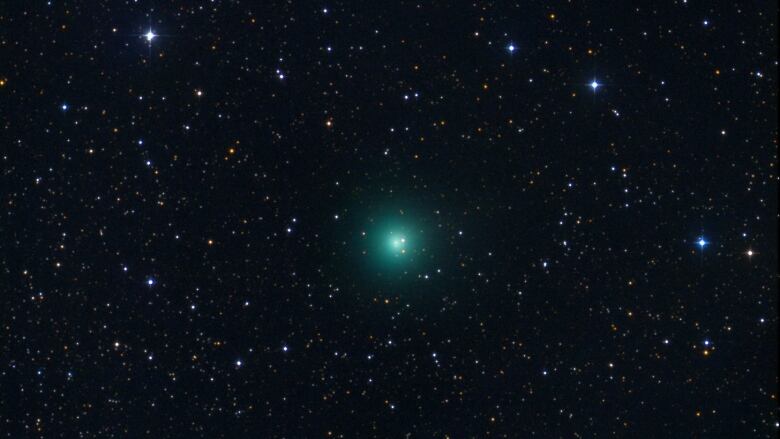Comet that may be visible to naked eye in August suddenly brightens
Comet C/2017 S3 was discovered by same Canadian astronomer who discovered first interstellar comet

It's green, fuzzy, and it just got a lot brighter.
Comet C/2017 S3, discovered last September by the Panoramic Survey Telescope and Rapid Response System (Pan-STARRS) team that included Canadian Robert Weryk in Hawaii, is getting closer to the sun and things are starting to heat up literally.
As comets collections of frozen gas and dust near the sun in their orbits, solar radiation heats up their centre, or nucleus, which causes water and gases to sublimate, going straight from ice to gas without becoming a liquid. This creates both the fuzziness and tail for which comets are known.
As a result of that process, it appears that C/2017 S3 has brightened significantly, with some comet watchers reporting that it has increased 16-fold. Its atmosphere is estimated to be almost twice as wide as Jupiter.
What makes this even more exciting is that C/2017 S3 is unique.
"Ones like this have never visited the inner solar system before," Weryk said. "We don't really know what the surface is, but it certainly can go through brightening like this."
#Comet C/2017 S3 ( #PANSTARRS) on July 3rd 23:30 UTC. It is in an #outburst at ~9mag. #Perihel should be reached in August, maybe at naked eye brightness, if it survives until then. 360s/180s/180s/180s L-RGB pic.twitter.com/8z0HW92lmS
—@U_RiethBecause little is known about it, no one can say for sure how bright it will get. However, it is expected to get very close to the sun in August within the orbit of Mercury though it won't be bright enough to see unless you're in very dark skies. Even then, you'll be pushing the limit of your eyes. However, it will be bright enough to spot with binoculars and telescopes.
"The activity is becoming much more active, and we rely on observers who are chasing all these comets regularly to tell us what the actual brightness is, so it's kind of hard to predict what these things will be," Weryk said.
So with this early outburst, further brightening could make this comet a naked-eye astronomical target yet.
Far-out visitor
C/2017 S3 originates from the Oort Cloud, a vast collection of ice and rock surrounding our solar system, 300 billion kilometres away. Every so often something gets knocked out of the cloud and begins a voyage into the inner solar system where it orbits near the sun.
The Pan-STARRStelescope is optimized to look for asteroids. However, once the automated system identified it, Weryk who most recently discovered the first known interstellar comet saw that it was fuzzy, indicated that outgassing was occurring, something that asteroids don't do.

In his time at the Institute for Astronomy at the University of Hawaii, Weryk said he estimates that he's found somewhere between 100 to 200 comets using Pan-STARRS and is continually finding more.
"There's always something to find," Weryk said.












_(720p).jpg)


 OFFICIAL HD MUSIC VIDEO.jpg)
.jpg)



























































































